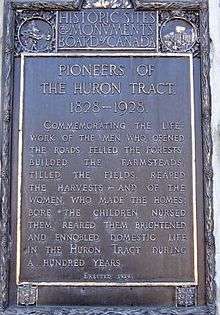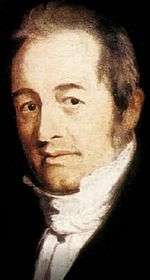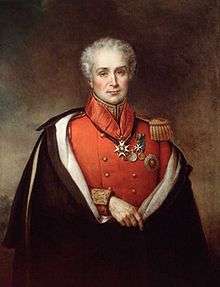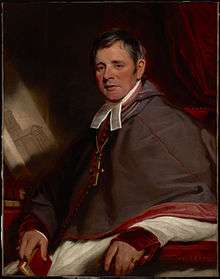Canada Company
.jpg) The country does not alter the race | |
| Land Settlement | |
| Industry | Resettlement from Britain and Europe to Upper Canada |
| Fate | Dissolved |
| Founded | 1825, c.75 |
| Founder | John Galt |
| Defunct | 1953 |
| Headquarters | England: No. 13, St. Helen's Place, Bishopsgate Street, London., Guelph, Upper Canada |
Number of locations | Huron Tract, Queen's Bush, Clergy Reserves |
Area served | Upper Canada |
Key people | John Galt, William Dunlop, Thomas Mercer Jones, William Allan, Daniel Lizars |
| Services | Land, roads, mills |
| Total equity | 2,000,000 acres (8,100 km2) of land |
The Canada Company was a large private chartered British land development company, incorporated by royal charter on August 19, 1826,[1] under an act of British parliament,[2] given royal assent on June 27, 1825,[3] to aid in the colonization of a large part of Upper Canada. Originally formed to acquire and develop Upper Canada's undeveloped clergy reserves and crown reserves[2] which, in 1827, the Company acquired for £341,000 ($693,000) from the Province of Upper Canada.[4]
Founded by John Galt who became its first Superintendent, the company was successful in populating the area called the Huron Tract an achievement later called "the most important single attempt at settlement in Canadian history".[5]
It is in unrelated to the modern Canadian charity of the same name founded in 2006, which assists former Canadian military members and their spouses regain civilian employment after service in the Canadian Armed Forces.[6]
| Amount | Area | Lands |
|---|---|---|
| £195,850 ($398,000) | 1,384,413 acres (5,603 km2) | Crown reserves |
| £145,150 ($295,000) | 1,100,000 acres (4,452 km2) | Recently acquired by the government, from the Chippewa First Nation, in what would become the Huron Tract, located on the eastern shore of Lake Huron, in substitution for the originally contemplated 829,430 acres (3,357 km2) of clergy reserve lands.[7] One-third of the purchase price went to fund public works and improvements, while the remaining two-thirds was paid to the Crown.[8] |
Mission

The Canada Company assisted emigrants by providing good ships, low fares, implements and tools, and inexpensive land. Scottish novelist John Galt was the company's first Canadian superintendent. He first settled in York (Toronto, Ontario) but selected Guelph as the company's headquarters, and his home. The area was previously part of the Halton Block, 42,000 acres of former Crown land.[9] Galt would later be considered as the founder of Guelph.[10]
The company surveyed and subdivided the massive Huron Tract, built roads, mills, and schools and advertised lots for sale to buyers in Europe. The company then assisted in the migration of new settlers, bringing them to the area by means of a boat, which the company also owned, on Lake Ontario.

A plaque erected in Huron county, Pioneers of the Huron Tract 1828-1928, commemorates the work of the men who developed the Huron Tract and the families who lived there, starting in 1828.[11]
John Galt was dismissed and recalled to Great Britain in 1829, for mismanagement, particularly incompetent bookkeeping.[12] General mismanagement and corruption within the company, and its close alliance with the Tory elites, known as the Family Compact, were important contributing factors to the Upper Canada Rebellion in 1837.
In 1833, his colleague William "Tiger" Dunlop took over as Superintendent of the Company and continued Galt's work for a short time before resigning.[13]
Company Structure
Appointed Secretary of the Canada Company in 1824 John Galt helped to obtain a charter for the company on 19 Aug. 1826.[12] On that date, the formal structure of the Canada Company was put into place by the company's Court of Directors. John Galt, as secretary, had the first order of business. Tabling an abstract of the charter, Galt declared the name to be "The Canada Company" with directors and secretary as served on the Provisional Committee and listed in the charter.[14]
At the first meeting of the board, it was declared that four directors would rotate off the Company beginning in 1829.
| Position | Persons concerned |
|---|---|
| Directors |
|
| Chairman |
|
| Secretary | |
| Auditors |
|
| Solicitors | |
| Bankers |
|
| Person | Role | |
|---|---|---|
 |
John Galt | Founder (1824–26), secretary (1824–1832), and first superindentent (1827–1829).[12] |
| William Allan | Commissioner of the Canada Company (1829–1841).[16] | |
| Frederick Widder | Commissioner of the Canada Company (1839–1864).[17] | |
| Thomas Mercer Jones | Commissioner of the Canada Company (1829–1852).[18] | |
 |
William Benjamin Robinson | Commissioner of the Canada Company (1852-1865), Senior Commissioner after 1865.[19] |
| Dr. William "Tiger" Dunlop | Warden of the Forests, later becoming Superintendent of the Canada Company. | |
| Person | Role | |
|---|---|---|
| Richard Alexander Tucker | Provincial Secretary of Upper Canada, having considerable influence over decisions made concerning the Company in its early years. | |
 |
Sir Peregrine Maitland | Lieutenant governor of Upper Canada. He became associated with the Family Compact. His authoritarian leadership style was one of the causes of the Rebellion of 1837. |
 |
Bishop Macdonnell | Roman Catholic Bishop attacked by William Lyon Mackenzie.
Alexander Macdonell was a Roman Catholic Scotsman who accepted the government promise of 200 acres (0.81 km2) in Upper Canada to every soldier who emigrated. He had been the chaplain of a Catholic Scottish Glengarry regiment. Macdonell was a conservative legislative councillor from 1831 leading the mainly Irish settlers against the Reform movement and Mackenzie. |
| Bishop Strachan | Protagonist in the Clergy Reserves issue.
An executive councillor in 1817 and legislative councillor in 1820 in the government of Upper Canada, Bishop Strachan sought special status for the Anglican church. | |
Dissolution of the Canada Company
When the Company sold its land to different purchasers, it reserved the mineral rights to itself. In 1919, the Company issued quit claims on such claims, vesting the mineral rights to the Crown. As a consequence, the Legislative Assembly of Ontario passed legislation in 1922[20] and 1923[21] authorizing the grant of such rights to landholders at a set price.
By 1938, the Canada Company held just over 20,000 acres (81 km2) acres of unsold land, while the company shares were valued at 10 shillings. It had become a land company in the process of liquidation.[14] By 1950, only 4,207 acres (17.03 km2) remained in its possession, distributed amongst Lambton County, the United Counties of Leeds and Grenville and Lanark County.[22]
In 1951, the remaining land was disposed, and land that was unsold became Pinery Provincial Park.[22]
The company voted to wind up its affairs on August 12, 1953,[23] and was dissolved on December 18, 1953.[22]
Sources
- Galt, John (1833). The autobiography of John Galt, 1779-1839. II. Philadelphia: Key & Biddle.
- Armstrong, Frederick H. (1985). Handbook of Upper Canadian Chronology (Revised ed.). ISBN 1-55002-543-0.
- Cameron, James McIntyre; Cameron, June Carolyn (1967). The early days in Guelph: Guelph and the Canada Company (PhD). Guelph: University of Guelph. OCLC 670494628.
- Coleman, Thelma; Anderson, James (1978). The Canada Company. Stratford: County of Perth and Cumming Publishers. ISBN 978-0-88988-029-0.
- Hall, Roger Dennis (1973). The Canada Company, 1826–1843 (PhD). University of Cambridge. OCLC 500461425.
- Karr, Clarence (1974). The Canada Land Company : the Early Years, an Experiment in Colonization 1823–1843. Toronto: Ontario Historical Society. OCLC 1230954.
- Lee, Robert C. (2004). The Canada Company and the Huron Tract 1826–1853: Personalities, Profits and Politics. Toronto: Natural Heritage Books. ISBN 1-896219-94-2.
- Lizars, Robina; Macfarlane Lizars, Kathleen (1896). In the days of the Canada company: The story of the settlement of the Huron tract and a view of the social life of the period (1825–1850). Introduction by G.M. Grant. Montreal and Halifax: William Briggs.
- Timothy, H. B. (1984). The Galts, a Canadian odyssey. Toronto: McClelland and Stewart. ISBN 0-7710-8457-9.
See also
References
- ↑ Canada Company: Charter of incorporation, 19th August, 1826. London: W. Marchant. 1832.
- 1 2 An Act to enable his Majesty to grant to a company, to incorporated by charter, to be called "The Canada Company", certain lands in the province of Upper Canada, and to invest the said company with certain powers and privileges, and other privileges relating thereto, 1825, c. 75 , later amended by 1916 c. xiv
- ↑ "No. 18154". The London Gazette. 12 July 1825. p. 1217.
- ↑ Armstrong 1985, p. 253.
- ↑ "Wellington County". Historic Plaques. Wayne Cook. 2011. Retrieved 21 March 2017.
Plaque #4
- ↑ "About Canada Company". Canada Company. Retrieved 9 September 2017.
- ↑ Lee 2004, pp. 39.
- ↑ "The Huron Tract". St Joseph Museum and Archives.
- ↑ Lee, Robert C. (2011). The Canada Company and the Huron Tract, 1826-1853. Hamilton, Ontario: Dundurn Books. p. 7. ISBN 978-1-89621-994-3.
- ↑ "The Canada Company". Quebec Gazette. August 9, 1827.
- ↑ "Plaque 24—Huron". Retrieved Sep 1, 2010.
- 1 2 3 Hall, Roger; Whistler, Nick (1988). "Galt, John". In Halpenny, Francess G. Dictionary of Canadian Biography. VII (1836–1850) (online ed.). University of Toronto Press.
- ↑ "Dr. William "Tiger" Dunlop, "the Unforgettable and the Unforgotten"". Guelph Archives. City of Guelph. 2011. Retrieved 22 March 2017.
- 1 2 Lee 2004, pp. 226–233.
- ↑ later part of Agra and Masterman's Bank, co-founder of the Anglo-Egyptian Bank
- ↑ In collaboration (1985). "Allan, William". In Halpenny, Francess G. Dictionary of Canadian Biography. VIII (1851–1860) (online ed.). University of Toronto Press.
- ↑ Wilson, Alan (1976). "Widder, Frederick". In Halpenny, Francess G. Dictionary of Canadian Biography. IX (1861–1870) (online ed.). University of Toronto Press.
- ↑ Roger D., Hall (1976). "Jones, Thomas Mercer". In Halpenny, Francess G. Dictionary of Canadian Biography. IX (1861–1870) (online ed.). University of Toronto Press.
- ↑ Jarvis, Julia (1972). "Robinson, William Benjamin". In Hayne, David. Dictionary of Canadian Biography. X (1871–1880) (online ed.). University of Toronto Press.
- ↑ The Canada Company's Lands Act, 1922, S.O. 1922, c. 24
- ↑ The Canada Company's Lands Act, 1923, S.O. 1923, c. 11
- 1 2 3 Lee 2004, p. 216.
- ↑ "No. 39941". The London Gazette. 18 August 1953. p. 4499.
Further reading
- "Canada Company fonds (F 129)". Archives of Ontario. Retrieved 2014-10-19.
- "Moving here, staying here: The Canadian immigrant experience". Library and Archives Canada. Retrieved 2010-12-12.
| Wikimedia Commons has media related to Canada Company. |